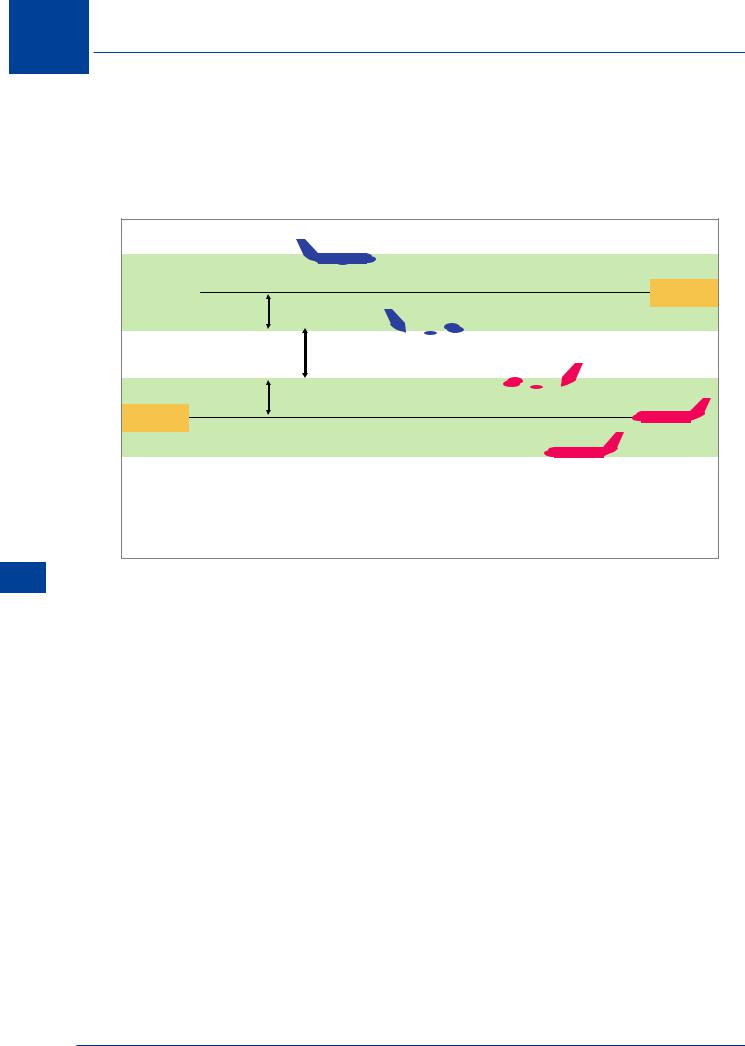
- •Textbook Series
- •Contents
- •1 Definitions
- •Introduction
- •Abbreviations
- •Definitions
- •2 International Agreements and Organizations
- •The Chicago Convention
- •International Law
- •Commercial Considerations
- •Customs and Excise, and Immigration
- •International Obligations of Contracted States
- •Duties of ICAO Member States
- •Status of Annex Components
- •The International Civil Aviation Organization (ICAO)
- •The Organization of ICAO
- •Regional Structure of ICAO
- •Regional Structure and Offices
- •ICAO Publications
- •Other International Agreements
- •The Conventions of Tokyo, the Hague and Montreal
- •The Warsaw Convention
- •The Rome Convention
- •IATA
- •ECAC
- •EASA
- •Eurocontrol
- •World Trade Organization
- •Geneva Convention
- •EU Regulation 261/2004
- •Questions
- •Answers
- •3 Airworthiness of Aircraft
- •Introduction
- •Airworthiness
- •Questions
- •Answers
- •4 Aircraft Nationality and Registration Marks
- •Introduction
- •Nationality and Registration Marks
- •Certification of Registration
- •Aircraft Markings
- •Classification of Aircraft
- •Questions
- •Answers
- •5 Flight Crew Licensing
- •Introduction
- •Definitions
- •General Rules Concerning Licensing
- •Licences and Ratings for Pilots
- •Multi-crew Pilot Licence (MPL)
- •Instrument Rating (Aeroplane) (IR(A))
- •Instructor and Examiner Rating
- •JAR-FCL 3 Medical Requirements
- •Pilot Proficiency
- •EASA Theoretical Knowledge Examinations
- •Questions
- •Answers
- •6 Rules of the Air
- •History
- •Applicability of the Rules of the Air
- •General Rules
- •Visual Flight Rules
- •Instrument Flight Rules
- •Semi-circular Flight Level Rules and RVSM
- •Special VFR
- •Distress and Urgency Signals
- •Restricted, Prohibited or Danger Areas
- •Signals for Aerodrome Traffic
- •Marshalling Signals
- •Flight Deck Signals
- •Questions
- •Answers
- •Instrument Procedures
- •PANS OPS
- •Instrument Departure Procedures
- •Questions
- •Answers
- •8 Approach Procedures
- •Procedure Basics
- •Approach Procedure Design
- •Obstacle Clearance Altitude/Height
- •Operating Minima
- •Descent Gradients
- •Track Reversal and Racetracks
- •Missed Approach Segment and Procedure
- •Published Information
- •RNAV Approach Procedures based on VOR/DME
- •Questions
- •Answers
- •9 Circling Approach
- •Circling Approach
- •Questions
- •Answers
- •10 Holding Procedures
- •Holding Procedures
- •Entry Sectors
- •ATC Considerations
- •Obstacle Clearance
- •Questions
- •Answers
- •11 Altimeter Setting Procedure
- •Altimeter Setting Objectives
- •Transition
- •Phases of Flight
- •Questions
- •Answers
- •12 Parallel or Near-parallel Runway Operation
- •Safety
- •Runway Spacing
- •Questions
- •Answers
- •13 SSR and ACAS
- •Airborne Collision Avoidance System (ACAS)
- •Questions
- •Answers
- •14 Airspace
- •Introduction
- •Control Areas and Zones
- •Classes of Airspace
- •Required Navigation Performance (RNP)
- •Airways and ATS Routes
- •Questions
- •Answers
- •15 Air Traffic Services
- •Introduction
- •Air Traffic Control
- •ATC Clearances
- •Control of Persons and Vehicles at Aerodromes
- •The Flight Information Service
- •The Alerting Service
- •Procedures
- •Questions
- •Answers
- •16 Separation
- •Concept of Separation
- •Vertical Separation
- •Horizontal Separation
- •Radar Separation
- •Procedural Wake Turbulence Separation
- •Radar Wake Turbulence Separation
- •Visual Separation in the Vicinity of Aerodromes
- •Stacking
- •Questions
- •Answers
- •17 Control of Aircraft
- •Procedural ATC
- •Radar Control
- •Radar Identification
- •Radar Service
- •Aerodrome Control
- •Approach Control Service
- •Air Traffic Advisory Service
- •Aircraft Emergencies
- •Questions
- •Answers
- •18 Aeronautical Information Service (AIS)
- •Introduction
- •General
- •The Integrated Aeronautical Information Package
- •The Aeronautical Information Publication (AIP)
- •Notices to Airmen (NOTAM)
- •SNOWTAM
- •ASHTAM
- •Aeronautical Information Circulars (AICs)
- •Pre-flight and Post-flight Information
- •Questions
- •Answers
- •Introduction
- •Aerodrome Reference Code
- •Glossary of Terms
- •Aerodrome Data
- •Runways
- •Taxiways
- •Aprons
- •Questions
- •Answers
- •Requirements
- •Visual Aids for Navigation
- •Runway Markings
- •Taxiway Markings
- •Signs
- •Markers
- •Visual Docking Guidance Systems
- •Questions
- •Answers
- •21 Aerodrome Lighting
- •Aerodrome Lights
- •Approach Lighting Systems
- •Runway Lighting
- •Taxiway Lighting
- •Questions
- •Answers
- •22 Obstacle Marking and Aerodrome Services
- •Introduction
- •Visual Aids for Denoting Obstacles
- •Visual Aids for Denoting Restricted Use Areas
- •Emergency and Other Services
- •Other Aerodrome Services
- •Questions
- •Answers
- •23 Facilitation
- •Entry and Departure of Aircraft
- •Questions
- •Answers
- •24 Search and Rescue
- •Definitions and Abbreviations
- •Establishment and Provision of SAR Service
- •Co-operation between States
- •Operating Procedures
- •Questions
- •Answers
- •25 Security
- •Introduction
- •Objectives
- •Organization
- •Preventative Security Measures
- •Management of Response to Acts of Unlawful Interference
- •Further Security Information
- •Questions
- •Answers
- •26 Aircraft Accident and Incident Investigation
- •Introduction
- •Objective of Investigation
- •Investigations
- •Serious Incidents
- •EU Considerations
- •Questions
- •Answers
- •27 Revision Questions
- •Revision Questions
- •Answers
- •EASA Specimen Examination
- •Answers to Specimen EASA Examination
- •28 Addendum – EASA Part-FCL & Part-MED
- •Chapter Five. Flight Crew Licensing
- •European Aviation Safety Agency (EASA)
- •Licences
- •Ratings
- •Certificates
- •EASA Part-MED
- •29 Index

Chapter
16
Separation
Concept of Separation . . . . . . . . . . . . . . . . . . . . . . |
. . |
. . |
|
. 291 |
Vertical Separation . . . . . . . . . . . . . . . . . . . . . . . . |
. . |
. |
. |
291 |
Horizontal Separation . . . . . . . . . . . . . . . . . . . . . . |
. . |
. . |
|
. 293 |
Radar Separation . . . . . . . . . . . . . . . . . . . . . . . . |
. . |
. . |
|
. 303 |
Procedural Wake Turbulence Separation . . . . . . . . . . . . . . . . |
. . |
. |
. |
303 |
Radar Wake Turbulence Separation . . . . . . . . . . . . . . . . . . |
. . |
. |
. |
308 |
Visual Separation in the Vicinity of Aerodromes . . . . . . . . . . . . . |
. . |
. |
. |
308 |
Stacking . . . . . . . . . . . . . . . . . . . . . . . . . . . . |
. . |
. |
. |
312 |
Questions . . . . . . . . . . . . . . . . . . . . . . . . . . . |
. . |
. |
. |
314 |
Answers . . . . . . . . . . . . . . . . . . . . . . . . . . . . |
. . |
. |
. |
322 |
289

16 Separation
Separation 16
290

Separation
Concept of Separation
16.1 General Provisions for the Separation of Controlled Traffic. Separation methods and minima are stipulated in ICAO PANS Document 4444. Within CAS the ATC service will make sure that all controlled flights (flights provided with ATC) are separated from each other to comply with the first requirement of the service - to prevent collisions between aircraft. Separation can be either:
•Vertical or
•Horizontal or
•Composite (a mixture of both - see para. 16.3)
It is applied to a defined standard, known as the separation minima. Separation is also applied to achieve spacing between aircraft to counter the effects of wake vortices and to facilitate timed arrivals and departures from busy aerodromes. Separation is applied:
•Between all flights in class A and B airspaces
•Between IFR flights in class C, D and E airspaces
•Between IFR flights and VFR flights in class C airspace
•Between IFR flights and special VFR flights
•Between special VFR flights, when so prescribed by the appropriate ATS authority
Note: IFR flights in VMC during daylight hours in classes D and E airspace may be cleared to climb and descend whilst maintaining own separation.
16.2Minimum Separation. Clearance will not be given to execute any manoeuvre that would reduce the spacing between two aircraft to less than the separation minimum applicable. Larger separations than the specified minima will be applied whenever wake turbulence or exceptional circumstances such as unlawful interference call for extra precautions. Whenever the type of separation or minimum used to separate two aircraft cannot be maintained, action shall be taken to ensure that another type of separation exists, or is established, when the previously applied separation becomes insufficient.
16.3Composite Separation. In circumstances where (usually due to an emergency or a serious deterioration in operating capability) the aircraft cannot maintain the necessary requirements for normal navigation, a compromise separation standard may be specified (in accordance with a RAN agreement), whereby the aircraft will take up altitude and track spacing not less than half that specified in the standards for normal separation. The RTF failure procedure for the NAT region specifies composite separation; likewise, the suggested procedure for unlawful interference where the pilot cannot maintain two-way RTF also specifies composite separation.
16.4Essential Traffic Information. Essential Traffic is defined as that controlled traffic to which ATC separation is applicable but to which in relation to another controlled flight is not, or will not, be separated by the required minimum. ‘Essential traffic information’ will be passed to the controlled flights concerned when they constitute essential traffic to each other.
Vertical Separation
16.5 Vertical Separation Minima. Wherever possible, ATC will arrange vertical separation to maximize the use of airspace and minimize horizontal use of airspace. Vertical separation is obtained by requiring aircraft using the same altimeter setting to fly at different levels expressed in terms of flight levels or altitudes dependent upon the magnetic track of the aircraft. The vertical separation minimum (VSM) is:
16
Separation 16
291

16 Separation
•Within designated airspace (subject to RAN agreement (RVSM)), a nominal 300 m (1000 ft) below FL410 or a higher level where so prescribed for use under specified conditions, and a nominal 600 m (2000 ft) at or above this level; and
•Within all other airspace: a nominal 300 m (1000 ft) below FL290 and a nominal 600 m (2000 ft) at or above this level.
Separation 16


 FL110 300 ft
FL110 300 ft
|
|
|
|
|
400 ft |
|
Safety “BUFFER” area |
||
|
||||
|
|
|
|
|
|
|
|
|
|
300 ft
FL100
ICAO LEVEL OCCUPANCY STANDARD = +/- 300 ft (UK applies +/- 200 ft standard)
Figure 16.1 ICAO level occupancy standard
16.6RVSM Cruising Levels. The RVSM cruising levels defined for domestic airspace (outside of the NAT MNPSA) are those between FL290 and FL410 inclusive. In other words, both FL290 and FL410 are RVSM levels.
16.7Minimum Cruising Level. Except when specifically authorized by the appropriate authority, cruising levels below the minimum flight altitudes (established by the State) shall not be assigned. Area Control Centres shall, when circumstances warrant it, determine the lowest usable flight level or levels for the whole or parts of the control area for which they are responsible, and use it when assigning flight levels and pass it to pilots on request. Unless otherwise prescribed by the State concerned, the lowest usable flight level is that which corresponds to, or is immediately above, the established minimum flight altitude. The portion of a control area for which a particular lowest usable flight level applies is determined in accordance with air traffic services requirements.
16.8Assignment of Cruising Level. An ACC will normally allocate only one cruising level to an aeroplane (except where cruise climb is authorized), for flight in the control area or for flight entering another control area.
16.9Level Change. If a change in cruising level is required, the aircraft is to request a level change en route (after initial clearance received). Aircraft, cruise climb authorized, will be cleared to operate between two levels. On ATS routes (airways) extending beyond the control area, level changes are to be effected over a radio navigation aid. If an aircraft has been cleared into a CTA below the minimum cruising level for that airspace, the ACC will issue a clearance to climb even though the pilot has not requested it. When necessary, an aircraft may be cleared to change cruising level at a specified time, place or rate.
292
